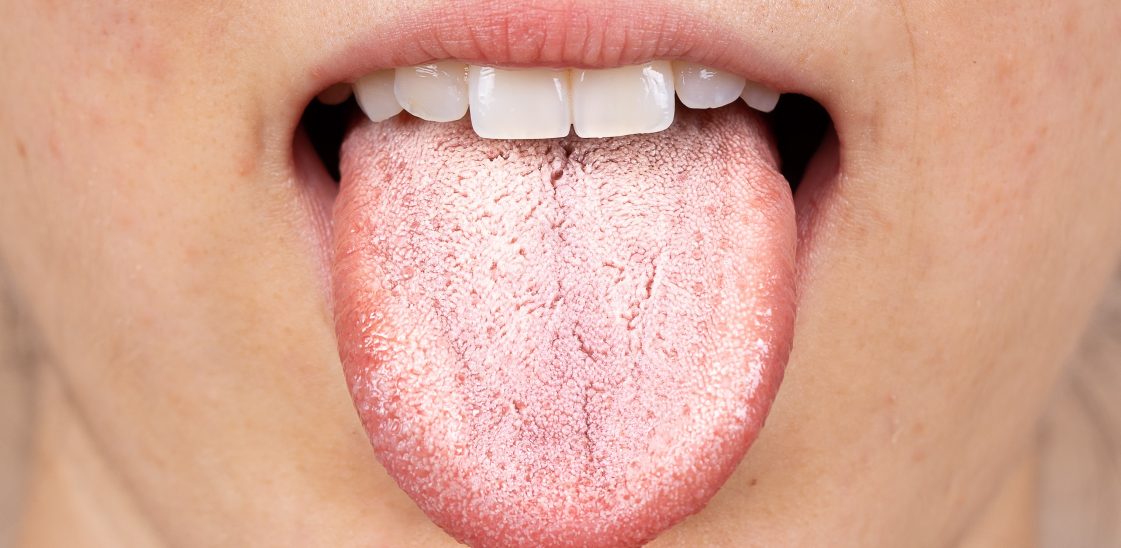
What is leukoplakia?
Leukoplakia is a term used to describe white patches on the tongue. These patches can also appear elsewhere in the mouth – for example, on the gums, the inside of the cheeks, or on the roof of the mouth. The patches are slightly raised and have irregular shapes – in other words, they’re rarely a perfect circle or oval. While they’re mostly white, the patches can appear slightly red in places, but they’re not typically painful.
Hairy leukoplakia is a specific type of leukoplakia that causes fuzzy, ridged white patches in the mouth. In both regular leukoplakia and hairy leukoplakia, the patches cannot be scraped or brushed away with a toothbrush or tongue scraper such as the long-handled Orabrush Tongue Cleaner. This handy tool uses ultra-soft micro-pointed bristles to loosen and remove bacteria on the tongue, leaving your mouth cleaner and fresher[1].
What causes leukoplakia?
Currently, the exact cause of leukoplakia isn’t known, but it’s thought to be related to irritation of the tissues in the mouth. It’s most commonly associated with tobacco – either smoked or chewed – so quitting may help to alleviate the condition. However, it can also be caused by other forms of irritation, such as:
- Abrasions caused by rough, uneven teeth or out-of-place dental implants – such as a denture that has come loose
- Biting the cheeks or tongue – whether accidentally or as an anxious habit
- Long term alcohol use
- Underlying inflammatory health conditions
Treating these conditions may relieve leukoplakia, or prevent it from occurring again.
Hairy leukoplakia is slightly different from regular leukoplakia. Although it has similar symptoms, it’s a different condition – and its cause is most commonly the Epstein-Barr virus. The Epstein-Barr virus is known for causing common conditions such as glandular fever, and it’s thought that most people will be infected with the virus at some point in their lives. It’s spread by exchanging bodily fluids, so you can get it just by sharing a cup with someone who is contagious. Not everyone experiences symptoms after being infected.
The Epstein-Barr virus usually becomes latent after the initial infection, which means it’s still alive, but inactive. It can reactivate at any point, which may or may not cause symptoms. You’re more likely to experience symptoms, including hairy leukoplakia, if your immune system is weakened for any reason[1].
How common is leukoplakia?
Leukoplakia is estimated to have a prevalence of less than 1%, meaning fewer than 1 in 100 people will have it. However, there are things which can increase your likelihood of developing leukoplakia, including smoking, excessive drinking of alcohol, and having a weakened immune system.
On top of this, there are several conditions which look similar to leukoplakia and can often lead to confusion if you self-diagnose. Other conditions that cause white patches in the mouth and throat include:
- Oral thrush
- Lichen planus – a rash that is usually accompanied by a stinging or burning sensation in the mouth
- Geographic tongue – a phenomenon where the shedding of old tongue cells creates patches on the surface of the tongue
- Mouth ulcers – sometimes also known as canker sores
You should always visit a GP or dentist if you’re not sure whether you have leukoplakia or any of the above conditions so that you can find out what you have and how it can be treated, if necessary. Take note when you brush your teeth if the patches can be brushed or scraped away – this can be important information that can help with a diagnosis[1].
Should I be worried about leukoplakia?
Most of the time, leukoplakia is nothing to be worried about. A doctor or dentist can recommend strategies to help reduce the size of the patches, or remove them altogether. For example, it might be recommended that you stop smoking or drinking.
You should also get regular check ups to make sure that the patches haven’t grown in size, changed shape, or changed colour. In rare cases, leukoplakia patches can become cancerous, which is why it’s so important to get white patches checked regularly. If they think there’s a chance your patches could become cancerous, doctors or dentists may recommend surgical removal. This would be done under local or general anaesthetic, so it wouldn’t be painful.
Hairy leukoplakia cannot become cancerous. However, you may need treatment for the Epstein-Barr virus, and for the weakening of your immune system[1].
Resources:




